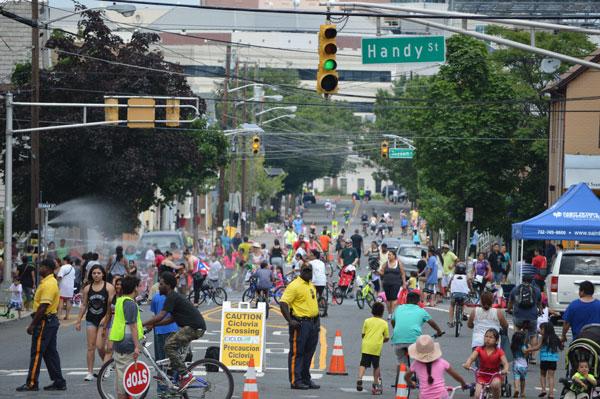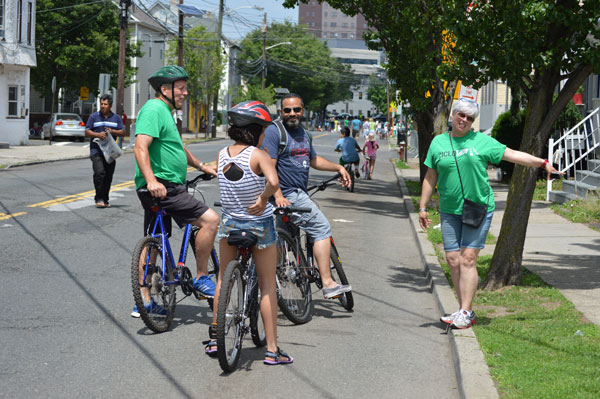 For the New Brunswick Ciclovia, equity isn't just a consideration — it's been at the center of the initiative from its conception.
For the New Brunswick Ciclovia, equity isn't just a consideration — it's been at the center of the initiative from its conception.
With 56,000 residents and the campus of Rutgers University, New Brunswick is home to a diverse mix of homeowners, renters, and students. Almost 50% of the population self identifies as Hispanic, Spanish is spoken at home by 46% of the population — and, like many urban areas, says Jaymie Santiago, Vice President of New Brunswick Tomorrow, the city is challenged by health disparities.
"In New Brunswick, childhood obesity is prevalent," Santiago says. "Diabetes and hypertension are prevalent. Issues related to vulnerable population groups and health disparities are very real in our community."
With that in mind, the New Brunswick Ciclovia was launched in 2013 with a clear mission: "To promote active living for the entire community through open and car-free streets." At the 2015 National Open Streets Summit a panel of organizers from the successful New Jersey initiative will share how they're meeting that mission by advancing equity and building a community of health.
To get a preview of the discussion, we spoke with two of the Ciclovia's leaders.

According to initiative leaders, the first piece of the equity puzzle has been an inclusive organizing process. While the initiative is "hosted" by New Brunswick Tomorrow, it's propelled by a diverse array of local organizations, from private hospitals to small community groups. "It’s very much a grasstops meets grassroots effort," Santiago says. "The credit really goes to the partners. New Brunswick Tomorrow serves as the host agency but I couldn’t do this on my own."
Charles Brown, Senior Researcher at Rutgers' Voorhees Transportation Center, agrees. "From day one, the committee reflected the community where the ciclovia was held, from a racial and ethnicity perspective," he says. And that participation has framed everything about the initiative, from the goals to the route itself.
"Our ciclovia really focuses on bridging the disparities in our vulnerable communities, so it’s an initiative that begins to connect different parts of the community, from the neighborhoods to the downtown municipal district to the commercial corridors to Rutgers University," Santiago says. "Culture tends to thrive where communities come together and share in one experience — Ciclovia is the only initiative in the city that attempts to connect all those communities and walks of life, and begins to shape the discussion of how we think about health disparities and the resources available in this community."

To make sure the initiative lives up to that vision, the organizers held themselves accountable by making it a clear goal: "To promote social interaction and social engagement." And, according to an evaluation of the 2013 initiative, co-authored by Brown, the Ciclovia met that benchmark.
"When we talk about equity, we’re talking about the presence of justice and fairness and the distribution of resources," Brown says. "Unlike some other cities that have hosted ciclovias in areas with disadvantaged populations, for this ciclovia, participation actually reflected those communities. We’ve seen examples in other cities that go through these particular neighborhoods but there wasn’t complete buy-in or support from the communities. In New Brunswick, we saw just that — the majority of people who came out reflecting the communities the Ciclovia went through, further promoting social interaction and engagement."
For Santiago, that diverse participation has a ripple effect, impacting health in ways that go far beyond the five-hour event.
"In the work I do in here at New Brunswick Tomorrow, we’re always looking at ways to improve quality of life for our residents," Santiago says. "Ciclovia helps to break down some of the barriers to the income segregation and, if you know anything about poverty and its systemic nature, one of the symptoms is isolation. Ciclovia really helps to break down those barriers, connecting folks and creating that social cohesion for success."
"It’s boosting morale and pride in local neighborhoods, which is a driver, I think, for creating safer, livable, more vibrant communities — communities that people really want to be a part of," he adds. "So it’s not just about health equity, it’s about leveling the playing field, so to speak, creating an atmosphere where you can meet and get to you’re your neighbors and start to think about how to lift an entire community."

How have they done it? With intentional outreach built on a foundation of research and inquiry into how their residents — nearly half of whom speak Spanish at home — learn about civic engagement opportunities.
"With the roots of the ciclovia movement in South America, this is not a foreign concept to a lot of our residents, so I think that works to our advantage," Santiago says. "With such a large demographic being Hispanic, they have some familiarity even if they’ve never seen the word. Ciclovia is actually a word mash but it sparks a thought — ciclo and via are two words that speak to the open streets movement."
"Nevertheless," he continues, "we had to educate people about what a ciclovia was, and, in the first year, we really focused on that. We took a strategic approach by identifying community leaders that can help us not just spread the word about the Ciclovia and build the momentum that way, but educate particular sectors of our community. We know from surveying in our community, which is predominantly Mexican American, that most get their information through word of mouth, about 67%. When we pressed them a bit further about where they get that information they said through their house of worship or their child’s school. So we used that as the foundation for outreach in the community."
But, according to Santiago, the Ciclovia isn't just engaging residents. It's also shifting the way community leaders, in a variety of sectors, think about community health.

"With each Ciclovia we’re seeing more and more of the partners and stakeholders involved thinking about themselves more so as health partners and less so as service providers," Santiago says. "So, for instance, if I’m a resident experiencing difficulty meeting my rent, which happens every day in New Brunswick, chances are I’m also experiencing difficulty accessing a doctor."
"How do we start to make those linkages?" Santiago continues. "How do I, as a provider helping you to meet your fiduciary responsibilities also start asking questions about whether you’re seeing a doctor? I think getting folks from different sectors to see themselves as a health partner through Ciclovia has been the biggest success story from 2013. And we’re gone from having 15 community-based partnerships to now, in 2015, over 35 community partnerships on the actual route, providing services, connecting folks to different resources. That’s the biggest successes for us."
As a transportation researcher, Brown sees additional metrics of success: Encouraging more residents to participate in physical activity — and support the city's investments in active transportation.
"I see tremendous opportunity for it to have that impact," Brown says. "When we had the first Ciclovia, we asked a question about whether participants were satisfied with the Ciclovia, whether they’d support continued funding and whether it changed their outlook on active transportation and, in each of those categories, people responded very positively — 94% satisfied with the Ciclovia, 94% said they would support continued city funding and 92% also stated that, as a result, of the Ciclovia they would consider walking and biking more often," he says. "So we already see the impact on people’s behavior, or at least their mindset, toward active transportation."
For Santiago changing minds has transformative potential.

"What we’re doing is transforming to a certain extent what it means to be healthy to this culture of creating community in a way that’s always looking to health and wellness as part of the context for living," he says.
Learn much more about New Brunswick Ciclovia and how you can make your Open Streets initiative more equitable at the 2015 National Open Streets Summit, September 25-27 in Atlanta. Register by August 14 for early-bird rates!
Photos courtesy of New Brunswick Ciclovia

